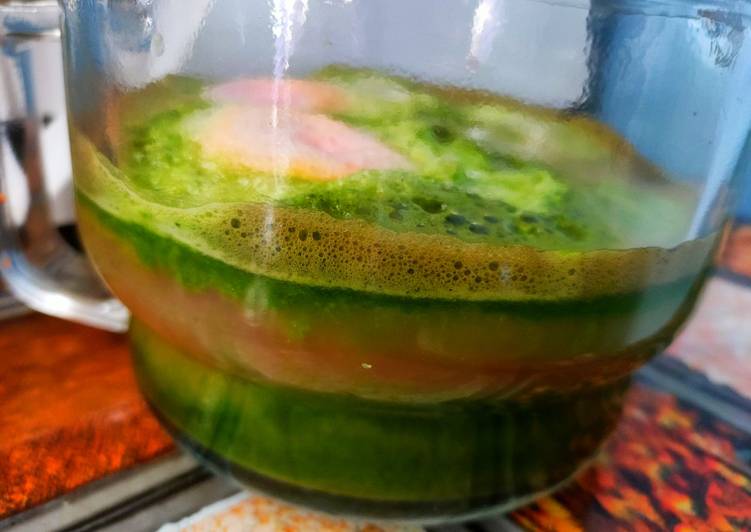
Hello everybody, hope you are having an incredible day today. Today, we’re going to make a special dish, vegetable juice. One of my favorites food recipes. For mine, I’m gonna make it a little bit unique. This is gonna smell and look delicious.
Vegetable juice is a juice drink made primarily of blended vegetables and also available in the form of powders. Vegetable juice is often mixed with fruits such as apples or grapes to improve flavor. The sweetness of carrot juice combines well with other commonly juiced vegetables and fruits, such as citrus fruits, ginger, and beets. Find out why juicing is an easy way to get your daily nutrients.
Vegetable juice is one of the most favored of current trending meals in the world. It’s appreciated by millions daily. It’s easy, it is fast, it tastes delicious. Vegetable juice is something which I’ve loved my entire life. They are nice and they look fantastic.
To begin with this recipe, we must first prepare a few components. You can have vegetable juice using 11 ingredients and 5 steps. Here is how you can achieve that.
The ingredients needed to make Vegetable juice:
- Get 5-6 leaves spinach
- Get 10 mint leaves
- Take 7 tulsi leaves
- Take 10 curry leaves
- Prepare Few carrot leaves (if available)
- Make ready 1-2 cucumber peeled and diced or sliced/ 1 cup diced bottlegourd
- Make ready 2 gooseberries (Amla)
- Get 1 big carrot peeled
- Prepare 1/2 beetroot peeled and diced
- Get 1 apple peeled and diced
- Make ready 2 inches ginger peeled
Juicing vegetables is one of the healthiest ways to get all your minimum daily requirements of Juiced veggies supply the body with nutrients you won't find in bottled juice or even the best. Fresh vegetable juice helps supply your body with readily available nutrition. Fresh vegetable juice not only tastes great, but it helps you eat, or in this case, drink more vegetables in a day than you. We all love fresh Fruit juice, but vegetable juicing recipes can be a bit brow-raising especially for those new to juicing.
Steps to make Vegetable juice:
- Wash and prepare all the ingredients. Put a glass under the outlet of the juice extractor to catch the juice. Start the machine and add fruits and veggies one at a time, pushing them downwards with a stick. Start with leaves followed by soft vegetables and fruits such as apple and cucumber. Add a few dices/sticks of solid vegetables like a carrot in between. This helps to extract juice from soft veggies. Keep some carrot dices for the end so all the juice remaining in the machine comes out.
- Sieve it and consume right away.
- Notes: juice extractor Vs a blender: 1. Juice extractor extracts juice by squeezing the veggies and fruits. No heat is produced during the process. So it maintains the enzymes. 2. No need to add water, so you get pure juice. WHEREAS a blender makes juice by breaking them down to the tiniest pieces, most of which gets sieved and what you retrieve is a glass of coloured and flavoured water that you added to be able to blend. Most enzymes and antioxidants evaporate due to the heat produced.
- You can change the quantity of the vegetables or totally skip as per your taste and availability. What is a must are - apple, carrots and cucumber /bottle gourd Apple adds sweetness, carrot adds much juice and cucumber/gourd helps to dilute the juice.
- Caution: Ensure that the vegetables are washed really well removing the bacteria as well as the chemicals. You may soak them in soda-bi-carb water (warm) for 10 -15 min before use OR use organic vegetables and fruits.
Fresh vegetable juice not only tastes great, but it helps you eat, or in this case, drink more vegetables in a day than you. We all love fresh Fruit juice, but vegetable juicing recipes can be a bit brow-raising especially for those new to juicing. Fresh fruits are naturally sweet but most vegetables aren't. The reasons for vegetable juicing and fruit juicing are the same, but vegetables have something much more important that fruits have less of — chlorophyll. Benefits of Parsley and Parsley Juice.
Try Using Food to Boost Your Mood
Mostly, people have been trained to think that “comfort” foods are bad for the body and have to be avoided. At times, if your comfort food is a high sugar food or another junk food, this holds true. Other times, comfort foods can be utterly nourishing and good for us to eat. Some foods really do elevate your mood when you eat them. If you seem to feel a little bit down and need a happiness pick me up, try a couple of these.
Eggs, would you believe, are terrific for helping you fight depression. You should be sure, though, that what you make includes the egg yolk. The yolk is the part of the egg that is the most important in terms of helping you cheer up. Eggs, the egg yolk particularly, are stuffed full of B vitamins. These B vitamins are wonderful for helping to raise your mood. This is because they increase the function of your brain’s neural transmitters (the parts of the brain that tell you how to feel). Eat an egg and be happy!
Put together several trail mix of nuts or seeds. Almonds, cashews, peanuts, pumpkin seeds, sunflower seeds, etc are all great for improving your mood. This is because seeds and nuts have lots of magnesium which increases your brain’s serotonin levels. Serotonin is a feel-good chemical substance that directs the brain how to feel at any given moment. The more serotonin in your brain, the more pleasant you’ll feel. Not just that, nuts, in particular, are a fantastic source of protein.
Cold water fish are great if you are wanting to feel happier. Herring, trout, tuna, wild salmon, and mackerel are all high in omega-3 fats and DHA. Omega-3 fatty acids and DHA are two things that raise the quality and the function of your brain’s grey matter. It’s true: consuming a tuna fish sandwich can seriously boost your mood.
Some grains are truly great for driving away bad moods. Quinoa, millet, teff and barley are all truly wonderful for helping raise your happiness levels. They help you feel full as well which can actually help to improve your mood. Feeling hungry can be awful! These grains can help your mood elevate since it’s easy for your body to digest them. These foods are easier to digest than others which helps promote a rise in your sugar levels which in turn brings up your mood to a happier place.
Green tea is truly good for your mood. You were simply expecting to read that in this article, weren’t you? Green tea is loaded with a certain amino acid called L-theanine. Studies show that this specific amino acid can essentially stimulate brain waves. This will better your brain’s focus while simultaneously relaxing the rest of your body. You knew green tea could help you be so much healthier. Now you are well aware that it helps you to raise your moods also!
Now you realize that junk food isn’t necessarily what you should eat when you want to help your moods get better. Try some of these hints instead.


